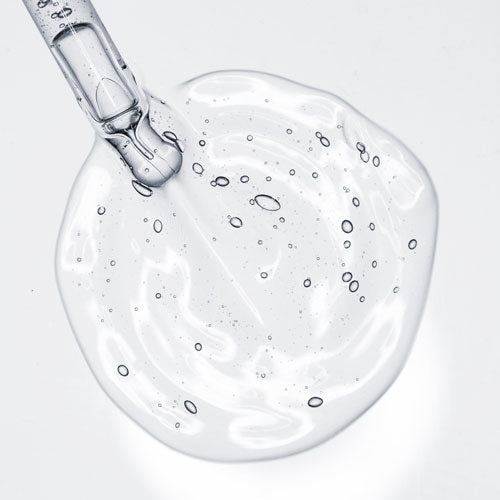If you're browsing through skincare aisles (or scrolling through online stores in your pyjamas - we're not judging!), niacinamide is an ingredient you will likely come across quite frequently – and for good reason.
But what is niacinamide, and what does it actually do?
Niacinamide is a biologically active form of niacin, otherwise known as vitamin B3. Niacin is a naturally occurring compound in both plants and animals as a derivative of the amino acid tryptophan. It is essential in the conversion of food nutrients into energy, as well as in the repair of DNA - we couldn't live without it!
Niacinamide, which is sometimes referred to as nicotinamide, is a water-soluble form of the vitamin which is commonly used for topical applications like skincare. Whilst it has secured its spot in skincare aisles in recent years, niacinamide has been used and recommended by dermatologists for decades.

What does it do?
Niacinamide is scientifically proven to have a wide array of benefits for the skin, making it no surprise that it has become touted as a skincare superhero.
- It is often used in treating acne and reducing blemishes(1) and is fantastic for balancing oil production for those with oily skin due to its ability to decrease and regulate sebum production(2)
- It can help reduce skin irritation and is even used in the treatment of psoriasis, rosacea and dermatitis(3). It's proven to improve skin barrier function(4) by increasing the abundance of protective barrier layer proteins and ceramides of the skin.
- As a moisturiser, it has shown to be more effective in restoring skin hydration levels and preventing trans-epidermal water loss than petrolatum(5). It is particularly effective at boosting moisture levels of the skin when combined with other humectants such as glycerine(6).
- It's also a powerful antioxidant(7) and is known to minimise the appearance of enlarged pores, fine lines and hyperpigmentation(8). It also helps boost radiance and clarity to promote a more-even skin tone and texture. The result? Smoother, clearer and younger-looking skin. Yes, please!
How do I use it?
This acne-fighting, skin-barrier-restoring, moisturising and anti-inflammatory miracle worker is best used in leave-on products so the skin can reap the most of the benefits it has to offer. Incorporate niacinamide into your skincare routine with serums and moisturisers that remain on the skin, rather than in cleansers which are only on the skin for moments before being washed away.
Niacinamide is a wonderfully cooperative compound which plays nicely with many other skincare active ingredients such as vitamin C, retinols and exfoliating acids (despite what you may have read). In fact, it has been proven to enhance the performance of other ingredients such as glycerine and ceramides by improving their water retention(9) and biosynthesis respectively(10).
Look for niacinamide serums or moisturisers which also contain humectants like glycerine or hyaluronic acid to boost moisture. As niacinamide can help reduce irritation induced from retinols and retinoids, it also makes an excellent pairing with many anti-aging skin care treatments. For a brighter, clearer complexion, niacinamide can be used with exfoliating alpha hydroxy acids (AHAs) and beta-hydroxy acids (BHAs).
In the correct dosage, niacinamide is safe, stable and effective – and its versatility in addressing an abundance of common skin concerns is greatly valued in the world of dermatology.
You can find niacinamide in our skincare range: Quench lightweight face moisturizer. Accompanying the wonder ingredient is a host of effective, good-for-you ingredients such as jojoba, panthenol (vitamin B5) and hyaluronic acid to help promote a smooth, healthy-looking complexion.
References:
[1a] Griffiths CEM. Nicotinamide 4% gel for the treatment of inflammatory acne vulgaris. J Dermatol Treat. 1996;6(Suppl 1):8–10.
[1b] Shalita AR, Smith JG, Parish LC, Sofman MS, Chalker DK, Topical nicotinamide compared with clindamycin gel in the treatment of inflammatory acne vulgaris. Int J Dermatol. 1995 Jun;34(6):434-7.
[2] Draelos, Z. D., Matsubara, A., & Smiles, K. (2006). The effect of 2% niacinamide on facial sebum production. Journal of cosmetic and laser therapy : official publication of the European Society for Laser Dermatology, 8(2), 96–101. https://doi.org/10.1080/14764170600717704
[3] Wozniacka A, Sysa-Jedrzejowska A, Adamus J, Gebicki J. Topical application of NADH for the treatment of rosacea and contact dermatitis. Clin Exp Dermatol. 2003;28:61–63.
[4a] Bissett DL (2002) Topical Niacinamide and barrier enhancement. Cutis 70S:8–12. International Journal of Dermatology, March 2005, pages 197-202.
[4b] Bissett DL, Oblong JE, Saud A, et al. Topical Niacinamide provides skin aging appearance benefits while enhancing barrier function. In: Elsner P, Maibach HI. (Eds,) Cosmeceuticals and Active Cosmetics, 2nd edn. New York: Taylor and Francis Group, 2005,421-440.
[5] International Journal of Dermatology, March 2005, pages 197-202.
[6] Bissett DL, Oblong JE, Saud A, et al. Topical Niacinamide provides skin aging appearance benefits while enhancing barrier function. In: Elsner P, Maibach HI. (Eds,) Cosmeceuticals and Active Cosmetics, 2nd edn. New York: Taylor and Francis Group, 2005,421-440.
[7] Yasuhiro Nishida, Eiji Yamashita and Wataru Miki, Quenching Activities of Common Hydrophilic and Lipophilic Antioxidants against Singlet Oxygen Using Chemiluminescence Detection System. Carotenoid Science, Vol.II, 2007, 16-20.
[8a] Kawada A, Konishi N, Oiso N, Kawara S, Date A., Evaluation of anti-wrinkle effects of a novel cosmetic containing niacinamide. Int J Cosmet Sci. 2004 Oct;26(5):231-8.
[8b] Bissett DL, et. al. Topical niacinamide reduces yellowing, wrinkling, red blotchiness, and hyperpigmented spots in aging facial skin. Int J Cosmet Sci. (2004).
[8c] Kimball AB, et. al. Reduction in the appearance of facial hyperpigmentation after use of moisturizers with a combination of topical niacinamide and N-acetyl glucosamine: results of a randomized, double-blind, vehicle-controlled trial. Br J Dermatol. (2010).
[9] Christman JC, et. al. Two randomized, controlled, comparative studies of the stratum corneum integrity benefits of two cosmetic Niacinamide/glycerin body moisturizers vs. conventional body moisturizers. J Drugs Dermatol. (2012).
[10] Tanno O, Ota Y, Kitamura N, et al. Nicotinamide increases biosynthesis of Ceramides as well as other stratum corneum lipids to improve the epidermal permeability barrier. Br J Dermatol. 2000;143:524-531.

 Impact
Impact Blog
Blog Store Locator
Store Locator

